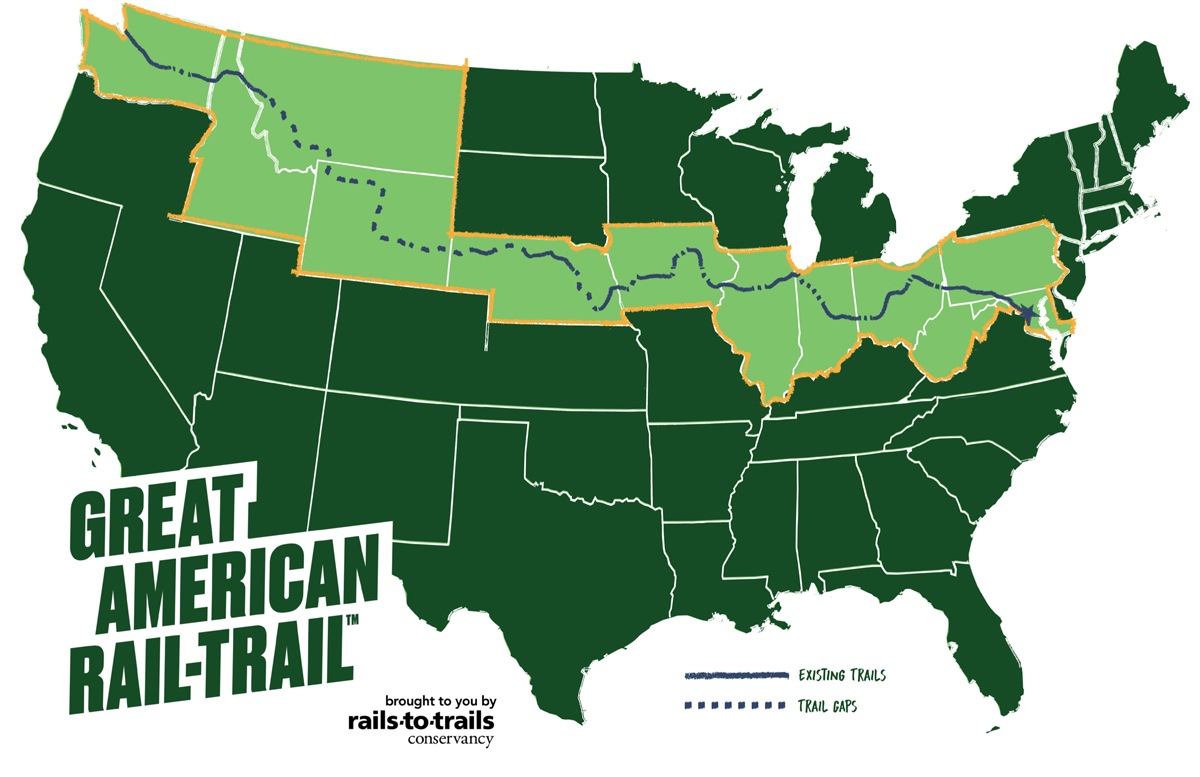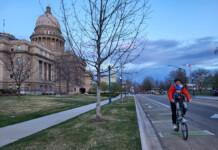By Charles Pekow –
Imagine taking a bicycle trip from Seattle to Washington DC – all on car-free designated bike lanes. It won’t remain a pipe dream. The Great American Rail-Trail going almost all the way across the country has been planned – and in fact is already more than half-built. The Rails-to-Trails Conservancy (RTC) unveiled the plan with the blessing of the U.S. Department of the Interior (DoI) at a May ceremony at the terminus (or beginning) of the trail, in Washington, DC, right in front of the U.S. Capitol. So you can ride across the country and deliver a message to Congress on the need for bike facilities as soon as you arrive!

I’m a member of RTC and attended the ceremony. The trail will cover more than 3,700 miles. It would run through Washington state, the Idaho panhandle, Wyoming, Nebraska, Iowa, Illinois, Indiana, Ohio, the northern tip of West Virginia, Pennsylvania, Maryland and the District of Columbia. According to RTC, almost 50 million people live within 50 miles of the route (greatamericanrailtrail.org).
RTC acknowledges, however, that the trial “will take several decades to complete.” While the trail is already nearly complete in Washington state and Idaho, it hasn’t been built or even completely mapped in Montana or Wyoming and several other states. In fact, more than 90 gaps between the dozen major and 113 smaller existing trail segments need to be filled. RTC says that initially, up to 20 percent of the route may have to be shared with autos while the rest is built.
Ryan Chao, who became RTC president in January, called the project “30 years in the making” and “the dream of our founders,” who started the organization in 1986. He said at the ceremony that RTC hopes to pick up a million supporters for the trail.
Rick May, senior adviser to the U.S. Secretary of the Interior for recreation attended the event and announced that DoI “stands by you as a partner in this endeavor.”
In Idaho, the trail will consist largely of the NorPac Trail and the Trail of the Coeur d’Alenes. All it needs is a 10.5-mile connection between the city of Plummer and the Washington state line. Farmers and other landowners possess some of the potential route.
But the project needs to work with state and local officials to build 344 miles in Montana. RTC wants the trail to go through Livingston, Bozeman, Three Forks, Butte and Missoula. But much of the hoped-for real estate remains privately owned. Only 83 miles, or 19.4 percent of the total, is built.
Wyoming also presents a challenge because of its geography. RTC’s Route Assessment Report acknowledges “there are not significant miles of multi-use trail available to route a trail across the state. As a result, Wyoming has more trail gaps to develop—at 500 miles—than any other state along the Great American route.” RTC hopes to go through Casper and Yellowstone National Park. Only 8.1 miles – or 1.6 percent of what’s needed – already is bikeable.
RTC reported that it met with state and local officials in Wyoming in January and identified several possible routes.
Building through public lands will require a lengthy process of public comment periods, environmental studies, etc.
“How can we go over the Rockies and keep the elevation relatively low for people of all abilities?” is a question Interior is working on, May said. But using railway right of way will prove a good method because old trains couldn’t do the steep mountains so the tracks were built to avoid the steepest climbs,he pointed out. “We’ll find a way around them,” May promised.
For more, see: railstotrails.org/greatamericanrailtrail








